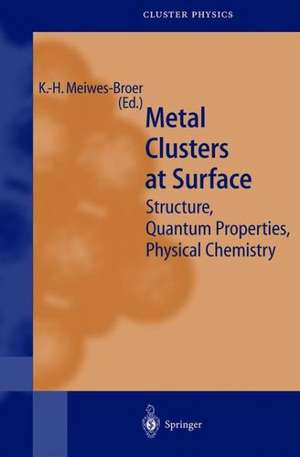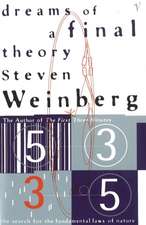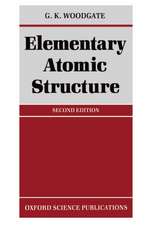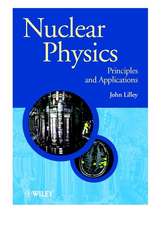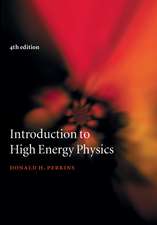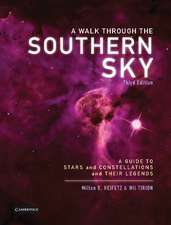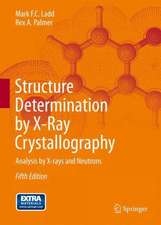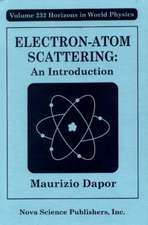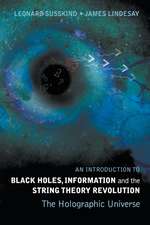Metal Clusters at Surfaces: Structure, Quantum Properties, Physical Chemistry: Springer Series in Cluster Physics
Editat de Karl-Heinz Meiwes-Broeren Limba Engleză Paperback – 21 oct 2012
| Toate formatele și edițiile | Preț | Express |
|---|---|---|
| Paperback (1) | 1000.56 lei 6-8 săpt. | |
| Springer Berlin, Heidelberg – 21 oct 2012 | 1000.56 lei 6-8 săpt. | |
| Hardback (1) | 1004.48 lei 6-8 săpt. | |
| Springer Berlin, Heidelberg – 5 apr 2000 | 1004.48 lei 6-8 săpt. |
Preț: 1000.56 lei
Preț vechi: 1220.19 lei
-18% Nou
Puncte Express: 1501
Preț estimativ în valută:
191.48€ • 199.17$ • 158.08£
191.48€ • 199.17$ • 158.08£
Carte tipărită la comandă
Livrare economică 15-29 aprilie
Preluare comenzi: 021 569.72.76
Specificații
ISBN-13: 9783642630644
ISBN-10: 3642630642
Pagini: 328
Ilustrații: XI, 310 p. 156 illus., 4 illus. in color.
Dimensiuni: 155 x 235 x 17 mm
Greutate: 0.46 kg
Ediția:Softcover reprint of the original 1st ed. 2000
Editura: Springer Berlin, Heidelberg
Colecția Springer
Seria Springer Series in Cluster Physics
Locul publicării:Berlin, Heidelberg, Germany
ISBN-10: 3642630642
Pagini: 328
Ilustrații: XI, 310 p. 156 illus., 4 illus. in color.
Dimensiuni: 155 x 235 x 17 mm
Greutate: 0.46 kg
Ediția:Softcover reprint of the original 1st ed. 2000
Editura: Springer Berlin, Heidelberg
Colecția Springer
Seria Springer Series in Cluster Physics
Locul publicării:Berlin, Heidelberg, Germany
Public țintă
ResearchCuprins
1 Confinement and Size Effects in Free Metal Clusters.- 1.1 Introduction.- 1.2 Free Simple Metal Clusters.- 1.3 Magnetic Particles in Molecular Beams.- 1.4 Conclusion.- 2 Fundamentals of Adsorbate-Surface Interactions.- 2.1 Introduction.- 2.2 Physisorption of Xenon on Graphite: Superstructure and Domain Boundaries.- 2.3 Chemisorption of Alkali Atoms on Semiconductor Surfaces.- 2.4 Bonding of C60 Molecules on Ag and Au(110) Surfaces.- 2.5 Electronic Response within the Cluster-Surface Interaction.- 2.6 Summary.- 3 Growth of Metal Clusters at Surfaces.- 3.1 Introduction.- 3.2 The Elementary Processes of MBE Growth.- 3.3 Nucleation.- 3.4 Aggregation.- 3.5 Coarsening.- 3.6 Anisotropic Surfaces.- 3.7 Growth of Cluster Arrays.- 3.8 Single Crystal Oxide Surfaces.- 3.9 Conclusion.- 4 Collision of Clusters with Surfaces.- 4.1 Introduction.- 4.2 Cluster-Surface Collisions: General Remarks.- 4.3 Experimental Considerations.- 4.4 Molecular Dynamics Calculations.- 4.5 Softlanding..- 4.6 Fragmentation.- 4.7 Implantation.- 4.8 Sputtering.- 4.9 Thin Film Formation by Energetic Cluster Impact.- 4.10 Cluster Impact Chemistry.- 4.11 Crater Formation and Cluster Impact Induced Erosion.- 4.12 Electronic Processes.- 4.13 Summary and Outlook.- 5 Electronic Level Structure of Metal Clusters at Surfaces.- 5.1 Introduction.- 5.2 Photoelectron Spectroscopy of Deposited Clusters.- 5.3 Scanning Tunnelling Spectroscopy and Inverse Photoemission.- 5.4 Summary.- 6 Conductance Quantisation in Metallic Point Contacts.- 6.1 Introduction.- 6.2 Landauer Theory for Ballistic Conductance.- 6.3 Experimental Techniques.- 6.4 Conductance of Atomic-Scale Contacts.- 6.5 Histograms of Conductance Values.- 6.6 The Character of the Conductance Modes Through a Single Atom.- 6.7 Chains of Atoms.- 6.8 Quantum Forces and Shell Structure in Alkali Nanowires.- 6.9 Discussion and Outlook.- 7 Magnetism of Nanometer-Sized Particles and Clustersr.- 7.1 Introduction.- 7.2 Single Particle Measurement Techniques.- 7.3 Mechanisms of Magnetisation Reversal in Single Domain Particles at Zero Kelvin.- 7.4 Influence of Temperature on Magnetisation Reversal.- 7.5 Magnetisation Reversal by Quantum Tunnelling.- 8 Physical Chemistry of Supported Clusters.- 8.1 Introduction.- 8.2 Supported Size-Distributed Model Catalysts.- 8.3 Supported Monodispersed Model Catalysts.- 8.4 Conclusions and Outlook.- 9 Application of Clusters to the Fabrication of Silicon Nanostructures.- 9.1 Prospects for the Application of Clusters.- 9.2 Silicon Nanostructures.- 9.3 Production of Cluster Films for Fabrication.- 9.4 Application of Metal Clusters as Plasma Etching Masks.- 9.5 Summary.
Caracteristici
The physics of clusters - which is an interesting field in itself - is combined here with the properties of solid surfaces This combination provides the physical basis for the understanding of metallic nanostructures
